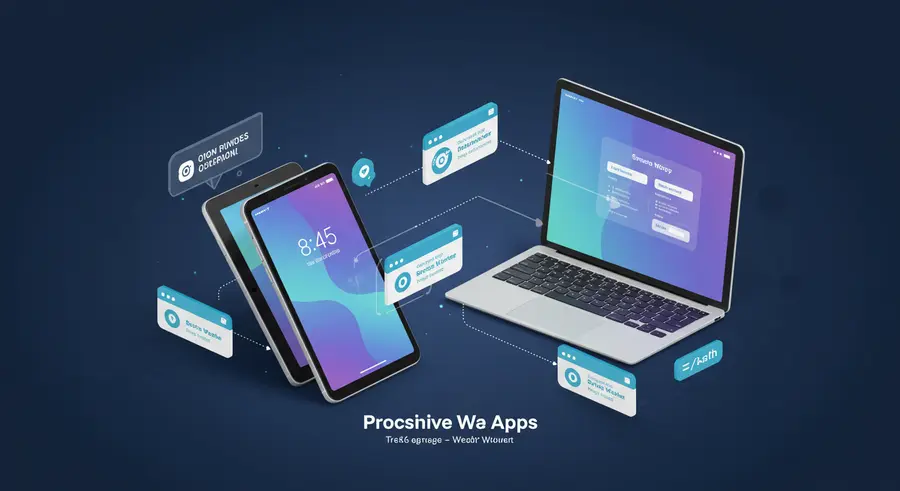Appearance

Welcome, fellow innovators and web enthusiasts! 👋 Today, we're embarking on an illuminating journey into the realm of Progressive Web Apps (PWAs). If you've been tracking the evolution of web development, you've undoubtedly heard the buzz around PWAs. But what exactly are they, and why are they considered the future of web experiences? Let's peel back the layers and explore this transformative technology with clarity and excitement!
What Exactly is a PWA? 🤔
Imagine a website that feels like a native mobile application – fast, reliable, and engaging, even when you're offline or have a shaky internet connection. That's the magic of a PWA! Coined by Google Chrome engineer Alex Russell, PWAs combine the best of both worlds: the broad reach of the web with the rich functionalities and user experience of a native app.
They are not just websites, nor are they traditional native apps. They are built using standard web technologies (HTML, CSS, JavaScript) but leverage modern browser capabilities to deliver an app-like experience.
Why PWAs? The Core Advantages That Drive Innovation 💡
The rise of PWAs isn't just a trend; it's a strategic shift driven by compelling benefits for both users and developers.
🚀 Blazing Fast & Reliable:
- Offline Access: Thanks to Service Workers, PWAs can cache essential resources, allowing users to access content even when they are offline or on unreliable networks. This is a game-changer for user experience!
- Instant Loading: Caching mechanisms ensure that PWAs load almost instantly after the first visit, significantly reducing bounce rates and improving engagement.
✨ Engaging & User-Friendly:
- App-like Experience: PWAs offer fluid animations, responsive design, and intuitive navigation that mimic native applications, providing a seamless user journey.
- Push Notifications: Re-engage users with timely and relevant updates, boosting retention and activity.
- Add to Home Screen: Users can "install" a PWA directly to their device's home screen, making it easily accessible without visiting an app store.
💰 Cost-Effective & Wider Reach:
- Single Codebase: Develop once, deploy everywhere! PWAs work across various devices and platforms (Android, iOS, desktop) from a single codebase, drastically cutting development and maintenance costs.
- No App Store Hassle: Bypass app store approval processes and their strict guidelines, allowing for quicker deployment and updates. This also means no commission fees!
- Search Engine Discoverability: Unlike native apps, PWAs are discoverable through search engines, increasing organic reach and visibility.
The Building Blocks of a PWA 🏗️
At the heart of every PWA are two fundamental components:
- Service Worker: A JavaScript file that runs in the background, separate from the web page. It acts as a programmable proxy, intercepting network requests, caching resources, and enabling offline capabilities and push notifications.
- Web App Manifest: A JSON file that provides information about the web application to the browser, such as its name, icons, start URL, display mode (fullscreen, standalone), and theme colors. This manifest is crucial for the "Add to Home Screen" functionality and for the PWA to feel like a native app.
Real-World Success Stories 🏆
Many prominent companies have successfully leveraged PWAs to enhance their user experience and achieve remarkable business growth:
- Twitter Lite: Reduced data usage by 70%, increased tweets sent by 19%, and improved load times.
- Spotify: Offers a seamless desktop experience, reducing load times and improving overall performance.
- Uber: Provides a lightweight app that works well on low-end devices and slow networks, crucial for its global user base.
- Pinterest: Saw a 40% increase in time spent on the app and a 60% increase in core engagements after launching their PWA.
- Trivago: Experienced a 150% increase in engagement for users who added their PWA to the home screen.
- Housing.com: Improved conversion rates by 38% and reduced bounce rates by 40% with their PWA.
These examples clearly demonstrate the tangible benefits of adopting PWA technology.
Navigating the Challenges 🚧
While PWAs offer a plethora of advantages, it's important to acknowledge some limitations:
- Limited iOS Support: While iOS has made significant strides in PWA support, some features like push notifications are still more restricted compared to Android.
- Hardware Access: PWAs might have limited access to certain device hardware features (e.g., advanced camera controls, NFC) compared to native apps, though this gap is continually narrowing.
- No Default App Store Presence: Without being listed in traditional app stores, discoverability relies heavily on web search and direct promotion.
Best Practices for PWA Development ✨
To build a truly impactful PWA, consider these best practices:
- HTTPS Everywhere: Always serve your PWA over HTTPS to ensure security and enable Service Worker registration.
- Responsive Design: Ensure your PWA looks and functions flawlessly across all screen sizes and devices.
- Offline-First Strategy: Design your PWA to prioritize offline functionality, providing a graceful fallback experience.
- Performance Optimization: Focus on fast loading times, smooth animations, and efficient resource utilization.
- Accessibility: Make your PWA usable for everyone, including those with disabilities, by following accessibility guidelines.
- Progressive Enhancement: Start with a basic, functional experience and progressively add advanced features as browser capabilities allow.
The Future is Progressive 🌐
Progressive Web Apps are not just a temporary solution; they represent a significant step forward in making the web more powerful, accessible, and user-friendly. By combining the best attributes of web and native applications, PWAs offer a compelling path for businesses and developers to reach a wider audience with engaging and reliable experiences.
If you're eager to learn more about the technical aspects and delve deeper into how PWAs function, be sure to check out the related catalogue entry on our site: The Power of Progressive Web Apps (PWAs).
Happy coding, and embrace the progressive future! 💖